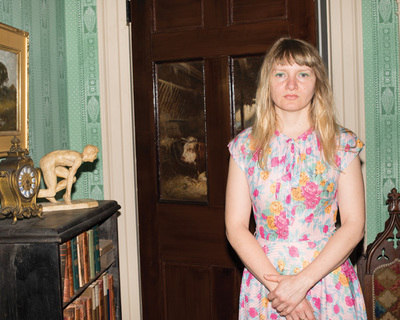IN PLACE: CONTEMPORARY PHOTOGRAPHERS ENVISION A MUSEUM
Can a museum be a muse? Can the halls, walls and grounds of a gallery inspire creation? And by searching for new truths in architecture and artifacts, are old ghosts raised or original ideas born? A photography exhibition at the Florence Griswold Museum makes us wonder. Below the surface of this graceful, elegant show, existential questions simmer.
In Place: Contemporary Photographers Envision a Museum assigns ten photographers one mission: capture the museum through your perspective. From late 2015 to the summer of 2016, a roster of artists ranging from revered pathbreakers to emerging talents reflected on this historic landmark, America’s oldest summer art colony, on the banks of the Lieutenant River. Most works were shot on site. The mood is celebratory; In Place marks the occasion of the museum’s latest land acquisition, a triumphant end to efforts ongoing since the 1940s to purchase the original 13 acres of Miss Florence’s estate, which were sold to settle debts shortly before her death. With the homestead finally pieced back together, it’s an apt time for reflection on the significance of the museum and grounds. This former home of the Lyme Art Colony, and birthplace of American Impressionism, has rich material for interpretation.
Cleverly curated by Amy Kurtz Lansing, In Place is stylishly organized, packaging three themes across three galleries. The photography is by turns representational and abstract, historical and digital. With the legacy in mind of giants like Childe Hassam and Willard Metcalf—both of whom stayed and painted at Miss Florence’s boardinghouse—the commissioned artists focused their lenses on landscapes and china cabinets, museum visitors and moonlit river vistas. Based on themes that emerged as the artists worked, photos are loosely categorized as Time
and Nature, Abstraction and Connection and Houses and Stories.
There are many reasons to linger at this exhibition as its layers reveal themselves. A standout in Time and Nature is Marion Belanger, a cultural landscape photographer based in Guilford, CT. In her tradition of thoughtful, immersive projects, Belanger created three studies of the museum’s surroundings through photography and printed books. She complements them with vitrines of archival remnants that informed her research and a video. Viewing her installation feels archaeological, a delving into issues of land use and permanence shot with Belanger’s precise, unflinching eye. It’s one of the ways In Place lures visitors into looking deeper into the nature of a historic site.
A walk through the Abstraction and Connection section will highlight Peter Daitch, who wields unique camerawork to melt landscape and architecture into elements of light, shape and glowing color. He paints through photography. Houses and Stories concludes the exhibition with works by Tina Barney, Adrien Broom and James Welling, all using the stillfurnished Griswold House as their setting. It’s surreal to recognize the same features refracted through their diverse sensibilities. In The Print Dress, Barney’s floral-frocked subject poses in Miss Florence’s parlor with an air of indie blasé, the room’s mint chip wallpaper echoing the exact shade of her eyeliner. Several frames to the right, Broom’s corseted model plays piano against shadows and smoke, her stiff Victorian dress enhancing the atmosphere of glamorous gloom. The wallpaper—and the title The Parlor—unmasks the room to be the same in both pictures. We’re glimpsing alternative realities, a past that might not have been and a present that is already past. This is the nature of photography, of memory. Guests can then visit the parlor for themselves, adding their own experiences to a kaleidoscope of possible nows.
Tina Barney, The Print Dress, 2016, chromogenic
color print, 40 x 50″. © Tina Barney, courtesy of Paul
Kasmin Gallery.
Several images lingered in this viewer’s mind for days—the eye makeup of Barney’s proud portrait, the light calmly gleaming on Welling’s still lifes of wooden floors and doors. But none more strongly than Daitch’s Griswold Architecture Series 2 – #7, 5/18/16, a creamy pine green and grey blur that slowly focuses into the museum’s threepointed rooftops. It’s a fragmented landscape evocative of crystal prisms yet ethereal rather than sharp. It has a hazy quality as if shot through gauze. Like many of Daitch’s photographs it creates the sense of motion, albeit the curious effect of going deeper within the frame rather than whizzing past. It is a compositional triumph and an emotional puzzle, freezing an unplaceable space in an unplaceable time. And yet we know exactly when it was taken, and where.

